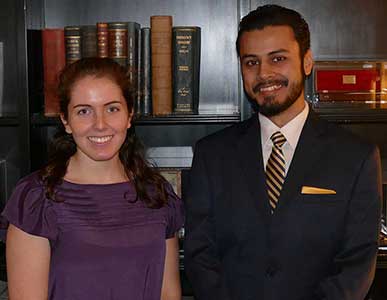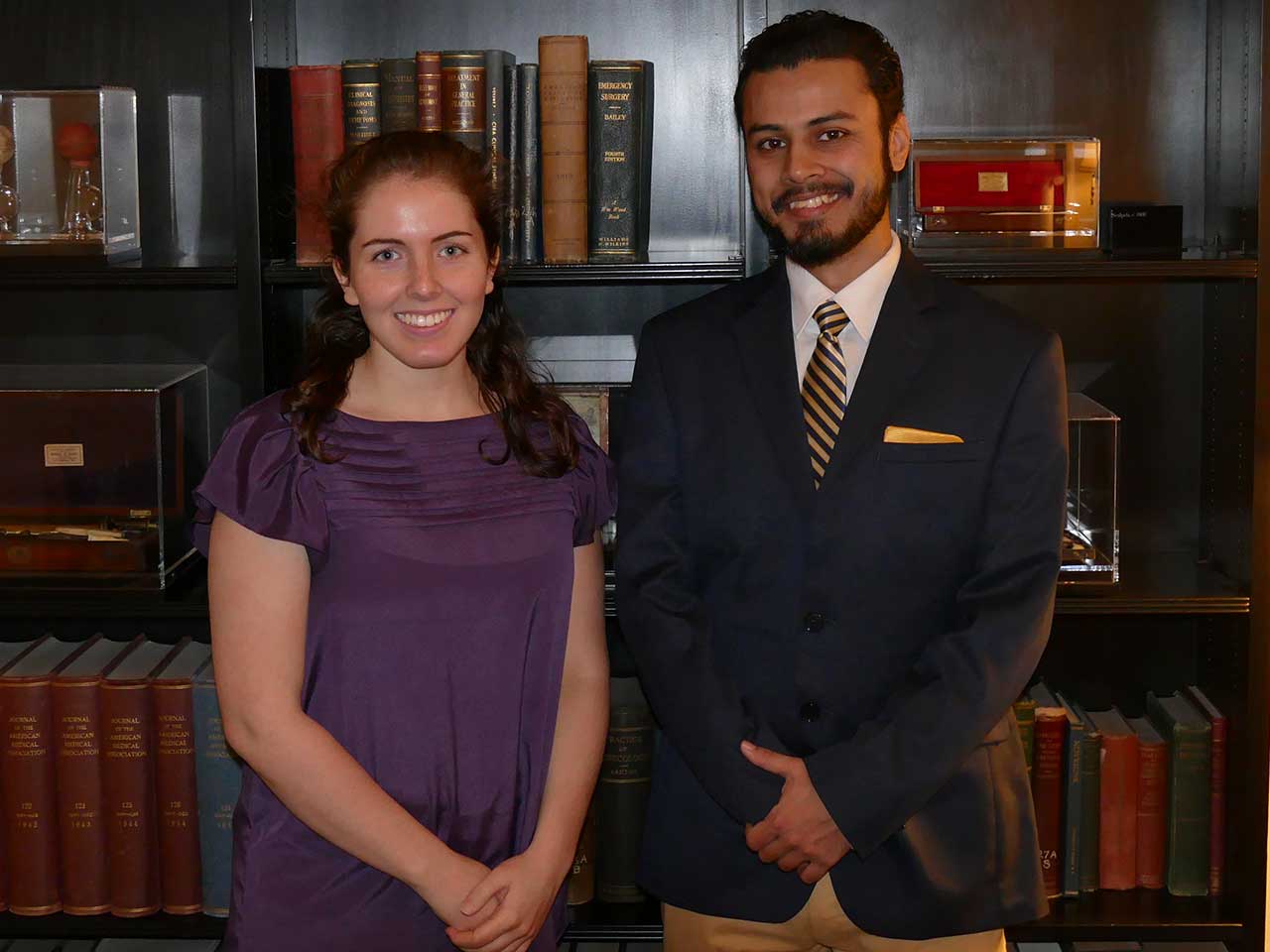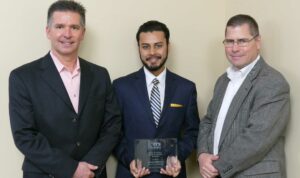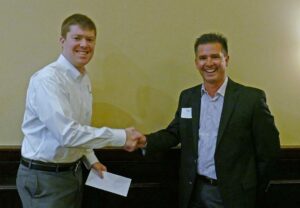2016 Wayne Shackelford Scholarship Winners

For the 8th consecutive year, the Intelligent Transportation Society of Georgia is supporting student involvement in intelligent transportation engineering and sciences through the Wayne Shackelford Engineering Scholarship Program. Mr. Shackelford was an early ITS visionary, co-founder of ITS Georgia and Georgia Department of Transportation Commissioner.

This year there are three winners.
The question answered by the candidates was: Assume that in 30 years Connected and Autonomous Vehicles will account for 100% of the vehicle fleet. In your opinion, what will the job of the ITS Professional look like in that future?
Anirban Chatterjee —
Anirban is a Computational Science and Engineering MS+PhD student at Georgia Tech planning to graduate in May 2019.
A future in which the vehicle fleet consists solely of connected and autonomous vehicles has the potential to create much safer and more efficient transportation systems. The job of the ITS professional will be to play two key roles in the realization of this potential: the long-term role of the researcher of core ITS concepts and the short-term role of the practitioner of ITS technology. To elaborate on these roles, it is important to first understand the possibilities in a future with a completely connected and autonomous vehicle fleet. In this essay, the possibilities of such a future are described, followed by how these developments will shape an ITS professional’s work.
The most visible impacts of a vehicle fleet that is completely autonomous and connected will be on traffic operations. Vehicle-to-vehicle communication will make traffic flow safer and much more efficient (Fagnant and Kockelman, 2014) in terms of both

time and energy. For example, coordinated vehicles will be able to operate with much lower headways between vehicles and at much higher speeds. Vehicles could weave seamlessly through intersections and locate vacant parking spots. Vehicles will be able to travel in platoons to improve energy efficiency. Most importantly, connected and autonomous vehicles will be able to significantly reduce road accidents and fatalities. Developing and improving this complicated level of communication and coordination between vehicles and the infrastructure around them will be the main focus of the long-term role of ITS professionals. Interdisciplinary teams of ITS professionals will have to continually research two core ITS concepts for improving traffic operations: the design of secure, reliable and efficient communication protocols between vehicles and the infrastructure around them and the development of algorithms to achieve efficient coordination among vehicles. 1
Beyond the long-term research, traffic operations will also define the short-term role of ITS professionals. Professionals in the ITS field will have to regularly fine tune vehicle behavior algorithms to accommodate the following changes. First, the algorithms mentioned above will depend on the shape, size and performance of the vehicles. New vehicle models and types will have to be accommodated. The self-driving technology itself will lead to a major change in vehicle design now that a driver’s seat, controls and even windows are not necessary. Second, updates will be required to reflect changes to the transportation infrastructure. Accurate mapping and navigation services are vital for autonomous vehicles and will require regular maintenance. Third, autonomous vehicles will require guidance in scenarios outside the scope of the programming of the vehicle. Ad-hoc behavior will have to be programmed to help vehicles respond to roadway incidents or natural disasters.
Autonomous and connected vehicles will have an effect off the road as well. In the next thirty years, the economics of parking can change significantly (Fagnant and Kockelman, 2014). With autonomous vehicles, the need for parking will be eliminated in many cases. Even when parking is the better option, vehicles can now drive themselves to and from parking locations far from destinations or other modes of transportation, which will have a strong impact on city planning, zoning laws and real estate. The design of these parking areas themselves can be optimized for machines. Lane access for every parking spot will no longer be necessary as surrounding cars would be able to move out of the way by themselves. The optimal storage of these vehicles will pose a complex logistical challenge for the ITS professional’s long-term role to create efficient transportation systems. In the short-term role, travel data from connected vehicles could be utilized to optimize parking locations and volume.
Apart from parking, ITS will also change other aspects of urban transportation, such as travel behavior and travel demand. Transportation networks will become increasingly complex as cities meld into megaregions (Meyer and Miller, 1984). Travel behavior and travel demand will change significantly because of the increased accessibility of on-demand services and the lack of a driver requirement. These changes will create new challenges in transportation planning. In the short-term role, ITS professionals could leverage the data collected by connected vehicles for the betterment of smart cities. Comprehensive and accurate travel data will be vital for transportation planning. Furthermore, road condition surveys can be crowd sourced from vehicles. 2
In thirty years, other technologies will develop as well to work in conjunction with the vehicles of the future. In the case of commercial vehicles, the loading and unloading systems will evolve to coordinate with vehicles. Vehicles could interact with refueling/recharging stations by themselves. The design of machines at commercial venues that work with these vehicles directly to load goods or conduct repairs could be a growing business. In the long-term, ITS professionals will have to design how vehicles schedule and queue at these machines safely and efficiently. In the short-term, an ITS professional will be responsible for completing this link between various vehicle types and these new supplementary technologies.
In conclusion, a fleet solely of connected and autonomous vehicles will have substantial impacts on transportation, the economy and the environment. This technology will bring an array of new possibilities and with each possibility, new challenges. ITS professionals will be at the forefront in realizing the potential of this technology. In the long-term, the work in this field will involve the betterment of algorithms and protocols that guide these vehicles to work safely and efficiently. In the short-term, ITS professionals will have a job that ranges from maintenance of traffic operations, optimization of urban planning and integration with new supplementary technologies.
References
[1] Fagnant, D. J. and Kockelman, K. (2014). The future of fully automated vehicles: opportunities for vehicle-and ride-sharing, with cost and emissions savings (Report No. SWUTC/2014/600451-00081-1). Springfield, VA: National Technical Information Service.
[2] Meyer, M. D. and Miller, E. J. (1984). Urban transportation planning: a decision-oriented approach. New York, NY: McGraw-Hill Education.
Anirban’s career objective is to: Apply my interest and expertise in sensing technologies and computer vision as a researcher in ITS for the betterment of the transportation field. I plan to achieve my career objectives in three ways. First, I will work on my own ideas on innovative applications of connected vehicle sensors to improve safety and efficiency in transportation systems. Second, I will continue my research on automated road condition surveys, which is currently applied by the Georgia DOT. Third, I plan to use my work as an example to promote an interest in solving transportation problems among students across various disciplines.
Zoe Turner-Yovanovitch —
Zoe is a Civil Engineering student who will graduate with a B.S. in December 2017
Roadways in America, and across the globe, will change in the coming decades as the prevalence of autonomous vehicles increases on the commercial and civil level. Driverless cars rely on infrastructure to operate, so infrastructure will have to change to accommodate this new vehicle fleet. The industry of errands will be flipped as vehicles, not people, traverse the city to accomplish daily tasks. The responsibility to the environment and the sustainability of economy will remain, but the regulatory powers and infrastructure that guides those two ideas will change as well. These are all major parts of the work of engineers concerned with intelligent transportation and their jobs will develop accordingly to the idea of a 100% autonomous vehicle fleet in 2046.

Clear and consistent roadway markings are essential to the success of the autonomous vehicle. With a completely driverless transit system on the roads, engineers have the opportunity to move past simple maintenance issues. There will be fewer to no novelty incidents that involve cars stopping on the side of a major freeway or running over, and running down, lane markings such as is the case today. Civil engineers will be able to build intelligent roads that incorporate LED lighting for obvious signaling as well as infrared or electromagnetic fields capable of being sensed by autonomous vehicles. Smart infrastructure could also aid the power sourcing issue that the increased number of cars on the road would face. Similar to light rail systems, it would be possible for vehicles to gain power from the road itself. Additionally, with the potential for less roadway damage, the surface space that a major interstates provide could be used for other projects, including solar power sourcing or routing of fiber-optic cables. The infrastructure that serves this new transportation fleet must become intelligent in order to match its users.
Once driverless cars are commonplace, every citizen will place the responsibility of performing simple daily tasks on their vehicle. Imagine ordering your groceries through a web interface and then sending your car to pick them up. Then, you send your car to deliver a package, pick up your eyeglass prescription, and maybe even drop your child off at soccer practice. The systems of everyday errands will change, and therefore so must the design of community places. Shopping center parking spaces will decrease as drive-through pick-up windows increase. Fewer people will pass through the front door and aisles of a grocery store as more cars drive on the roads to reach the same destination. These new movement patterns must be considered in the designing of frequently visited areas. Solutions may include multilevel drive-through stations and smart sensing or matching of the cars to their purchased items in order to reduce wait time. Perhaps more emphasis will be put on the volume of vehicles that can reach consumer destinations and less on the pleasant architecture that no human will see again. Whatever creative solutions may come about, it will be the new responsibility of ITS professionals.
Although the efficiency of individual trips may increase with a 100% autonomous vehicle fleet, the total number of trips, and therefore volume of cars on the road, will increase. The environmental impacts of this change would be disastrously negative, but professionals and citizens still have a responsibility to the earth. Therefore, research and the development of nonpolluting, renewable energy for cars will gain even higher global importance. With the idea of renewable energy comes the idea of using less energy in the first place, with which ITS professionals could help. By routing driverless cars in the most efficient way possible and building infrastructure that aids the continuous flow of traffic (no stopping, stalling, and starting again that burns fuel), they would be doing their part to reduce the energy used by the vehicle fleet. Additionally, regulations may be imposed to limit or manage the usage of autonomous vehicles. This system would hold accountable users that have their cars on the road all day to a higher tax than those who only use their vehicles for daily or fewer trips. Discrete road tolls, similar to those that exist today, maybe one part of ensuring that those who use the roads most pay for their development. This may be the greatest challenge that ITS professionals face, with the knowledge that infrastructure design solutions are far more effective than legislature acts.
The creative possibilities for intelligent infrastructure are endless. Ideas of underground, highly compact, self park areas for autonomous vehicles and more have already been imagined. The core responsibilities of transportation engineers and intelligent transportation system professionals remain the same: create safe, reliable, and efficient transportation services and infrastructure for all users; incorporate sustainable design and economically responsible practices in the development of new systems and infrastructure; and retain a professional and civic duty to the environment and community at large. Although transportation may look very different in 30 years in the future, professionals will evolve, develop, and build a better world for it.
Zoe’s career objectives include furthering he civil engineering education and gaining experience in the designing, planning and implementation of dynamic transportation systems. Working on intelligent transportation systems would be highly valued and is a top interest. She also aims to promote sustainability and community in her work.
William Woolery —
William is a Civil Engineering student at Georgia Tech and expects to graduate with a B.S. in December 2016
Technology continues to redesign life including the prediction that in thirty years, the future transportation model will be 100% connected and autonomous vehicle systems. With transportation structures rapidly transformed, there will be new challenges and responsibilities for the Intelligent Transportation Society (ITS) professional.

By 2046 the ITS professional will be required to be a transportation visionary. The autonomous vehicle movement and structure will demand an ITS leader who understands and is well informed about not only all levels of transportation and passenger movement, but knowledgeable extending to the environment, population shifts, legislature, and academia. Remodeling present transportation infrastructures and developing greater systems of safety for the future vehicle modes on the ground, below the ground and “hovering” above the ground will be a necessity for the ITS professional. More complex intricate traffic processes will involve more collaboration and communication by the ITS expert with all transportation types because systems will be interdependent on each other. The ITS practitioner will build or integrate computer programs that will sustain a multifaceted level of traffic monitoring for vehicles, passenger flow, as well as for safety operations. Transportation engineers will play a greater role in educating the public on how transportation innovations impact/improve the population’s work-life balance. Tasks will include finding ways to get the population ‘transportation technology connected’ at the same level so all can take advantage of future transportation models no matter what economic level. Future transportation professionals will be expected to adopt plans that only align with green highway standards and to match priorities/ideas of how to increase transportation-environmental sustainability.
Professionals will evaluate each transportation model to ensure the model fits the needs of the community it serves. Key connected attributes will encompass, high speed commuter rail and bus rapid transit for high capacity corridors, jet aircraft for long distance travel, and shared autonomous vehicles for everything in-between. For autonomous vehicles in densely populated areas and cities, the ITS expert will focus on paying attention to the last mile connectivity and connections to support rail and other high capacity or mass transit options. Professionals will strategize travel methods to effortlessly switch between vehicles, busses, trains, and planes therefore reducing travel time and increasing ease of access to transportation. Parking garages of the future, built into transit hubs, will be designed not only to allow for vehicle storage, but also to allow users to queue in a loading area with clear wayfinding, to provide a quick and seamless transfer. Then, travelers going the same direction will be whisked away in shared vehicles to their final destination. The travel model system, vehicle and sensor design, and loading and unloading algorithms will be designed and maintained by ITS expert. In more rural areas where mass transit economically cannot be supported, the ITS specialist will plan navigation routes using shared autonomous vehicles for highways, arterials, and local roads.
An ITS career will require development and incorporating higher systems of safety planning. Maintaining and updating the operational driving environment to ensure that autonomous vehicles can navigate roadways safely will be essential. The best safety practices which worked well with human operated automobiles will not necessarily be the safest for autonomous vehicles. Key sensing equipment will need to be developed, as well as reasonably priced for the general public, to allow vehicles to interact with each other and allow vehicles to sense the environment around them. ITS planners will need to consider all potential safety risks as example; sensors fail to correctly interpret the autonomous vehicle’s position on the roadway causing a crash due to unmaintained pavement markings. Safety awareness oversight, development, and maintenance will include expanding technology for traffic signals to communicate with vehicles. Traditional signal phases and timing will need to be recalculated based on the behavior of autonomous vehicles. Also it will be expected for the ITS professional to communicate and educate others regarding all new integrated safety systems.
The ITS professional will be coordinating a 100% connected and autonomous vehicle fleet along with nation-wide transportation systems as well as being a contributor to environmental strategic planning . A smart phone app designed by the ITS leader will be used to allow the public to enter their final transportation destination and route for their autonomous vehicle through the travel network. Planning of this app will provide the passenger to experience the ride as if they had their own private automobile. This will deliver similar comfort and ease as a traditional auto ownership experience as well as not contributing to traffic congestion. The ITS expert will play a significant role as key stewards to ensure that elements of environmental resource conservation are top priority in collaboration with the autonomous vehicle system. There will be a critical alliance between the ITS professional and multiple agencies and systems which support green highway principles.
Thirty years from now, the ITS professional will play a key role in planning and advising for the future of transportation connected and autonomous vehicle systems not only locally but nationally and globally for millions of people. The ITS expert will oversee the development, design, and advocate stewardship of all processes, as well as, assure operating efficiencies for autonomous vehicles. The ITS specialist will constantly innovate, explore, and continually monitor for new opportunities and improvements.
William looks forward to graduating from Georgia Tech with his BS/MS in transportation engineering and passing the EIT exam. His advanced career objectives includes successful completion of the PE exam and a career in transportation engineering either with a government agency or large engineering firm.